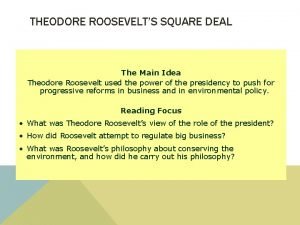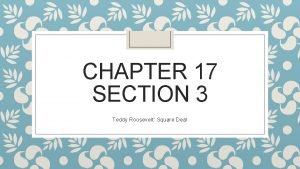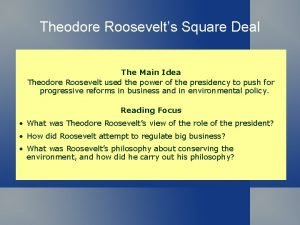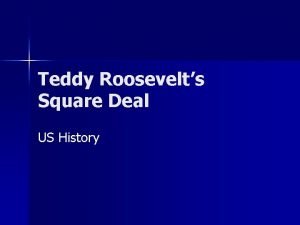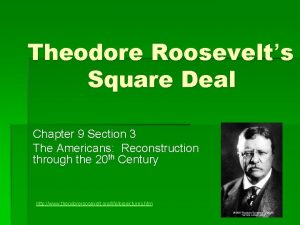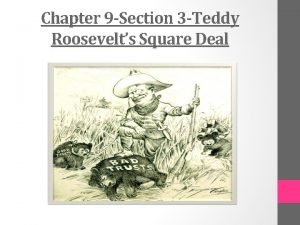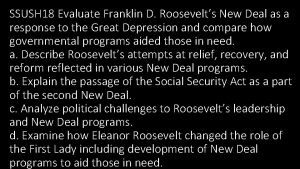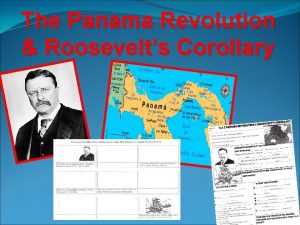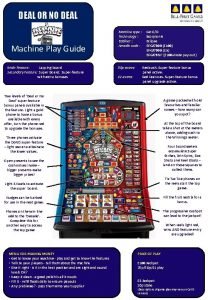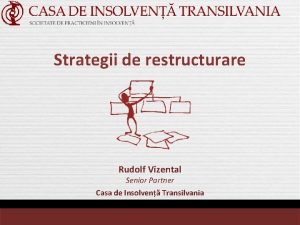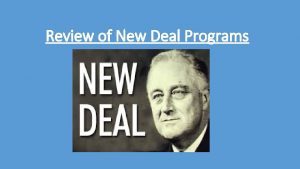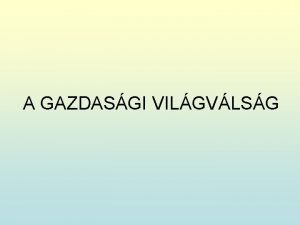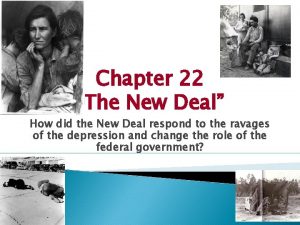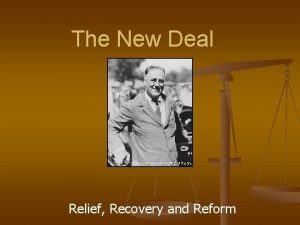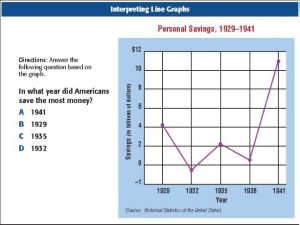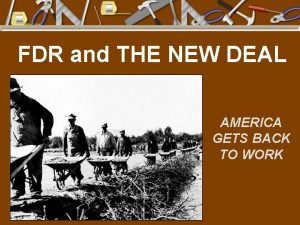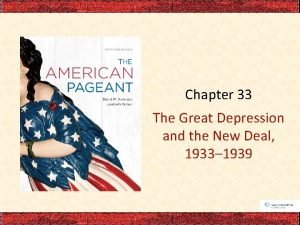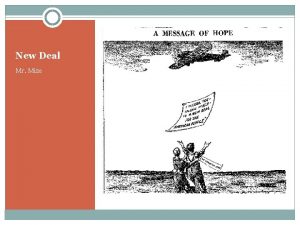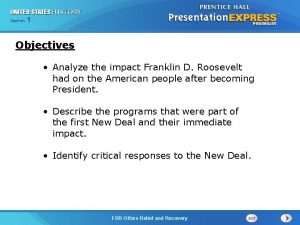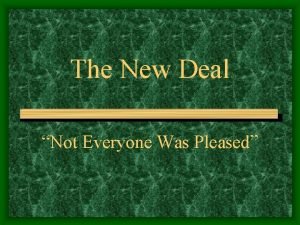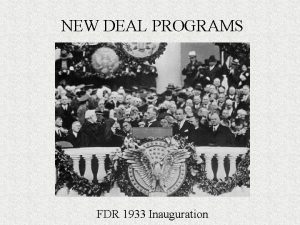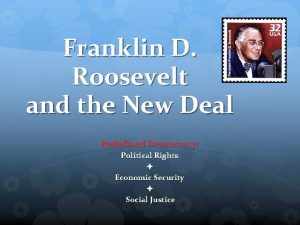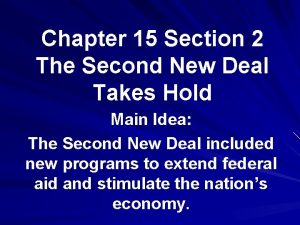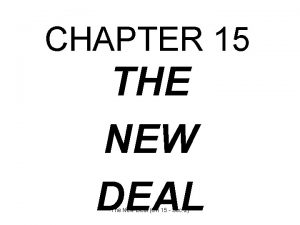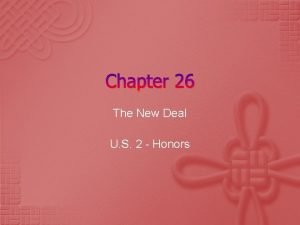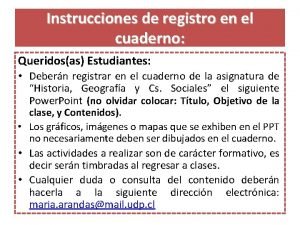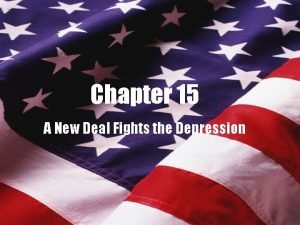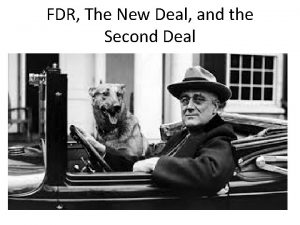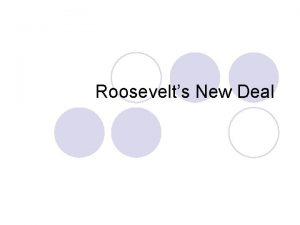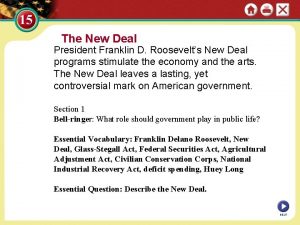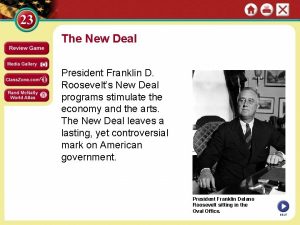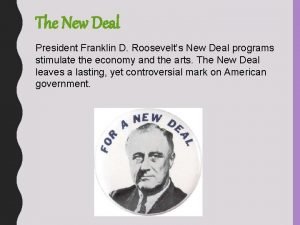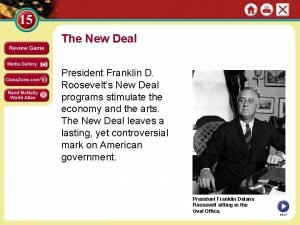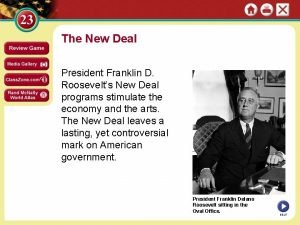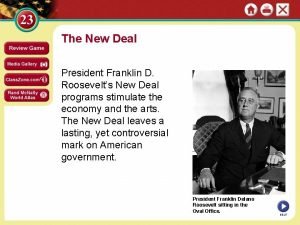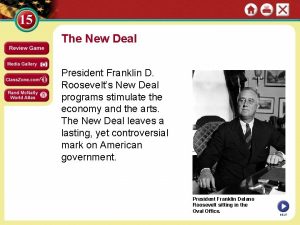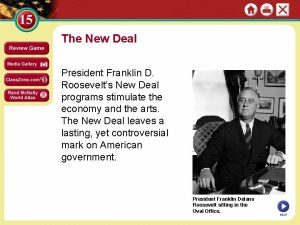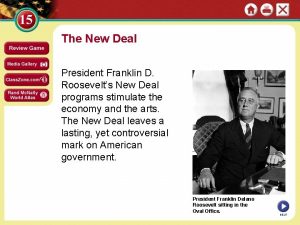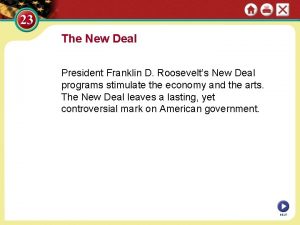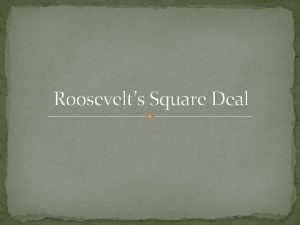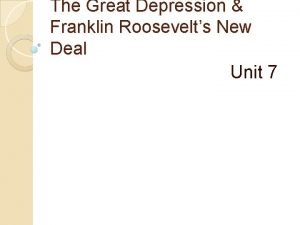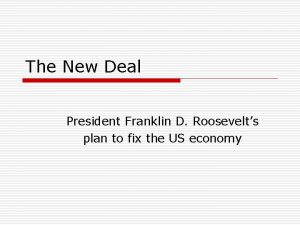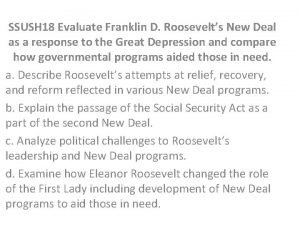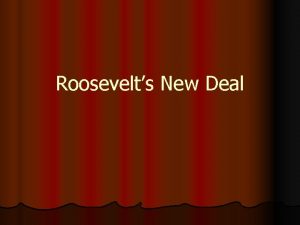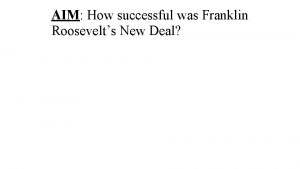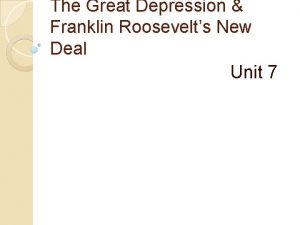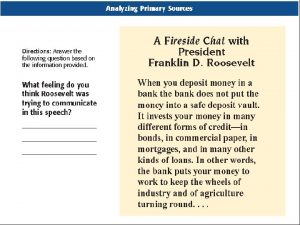The New Deal Franklin Roosevelts New Deal tackled


































- Slides: 34

The New Deal Franklin Roosevelt’s New Deal tackled the Great Depression with massive federal programs designed to bring about relief, recovery, and reform.

I. Franklin Roosevelt (1882 -1945) A. Background 1. Born in Hyde Park, NY to a wealthy family 2. Undersecretary of the Navy during WWI 3. Democratic vice presidential nominee in 1920 4. Contracted polio in 1921 5. Elected governor of NY in 1928 and 1930 -- His depression-era programs gained national attention 6. Master politician who was willing to compromise B. Eleanor Roosevelt (1884 -1962) 1. Niece of Theodore Roosevelt and distant cousin of FDR 2. She kept FDR’s political career alive in the 1920 s while he was dealing with polio 3. She became a major figure of the female wing of the Democratic party

4. During FDR’s first two terms, she essentially served as the “conscience” of the New Deal 5. She championed causes for women, children, the poor, and African Americans 6. Most active first lady in U. S. History II. Election of 1932 A. Democrats nominated Roosevelt 1. "I pledge you, I pledge myself to a new deal for the American people. ” 2. Platform was vague and contradictory during the campaign a. Promised a balanced budget and 25% cuts in gov’t spending b. Promised gov’t aid for the unemployed c. Advocated the repeal of prohibition

B. Republicans re-nominated Hoover 1. Platform: high tariffs, maintenance of the gold standard, free-enterprise 2. Reaffirmed his faith in free-enterprise and individual initiative 3. His defensive tone contrasted Roosevelt’s optimism C. Roosevelt defeated Hoover 472 -59 1. African Americans who had been loyal to the Republican party began shifting to the Democratic party a. The shift was complete by 1936 b. Blacks became a vital force in the Democratic party 2. Election signaled a 20 -year era of Democratic dominance of the federal gov’t

D. “Lame duck” period 1. Hoover tried to influence FDR into maintaining the gold standard and other anti-inflationary measures. 2. By FDR’s inauguration, the nation’s economy had ground to a halt 3. Twenty-first Amendment passed in February, 1933 a. Ended prohibition in Dec. 1933 b. Congress legalized beer in March E. Twentieth Amendment, 1933 -- Reduced “lame duck” period by six weeks (effective in 1937) III. Effects of the Great Depression by 1932 A. 25%-33% unemployment B. About 25% of banks failed C. 25% of farmers lost their farms D. Thousands of businesses failed IV. The New Deal FDRs 1933 Inaugural: “…. the only thing we have to fear is fear itself. ”

The “Three R’s” of the New Deal Relief (short term) Recovery (medium term) CCC, WPA, PWA, FERA, NYA N R A E B R A A SSA, FDIC, Wagner Act, Reform TVA, FHA, SEC, REA, Fair (Long term) Labor Standards Act, Indian Reorganization Act Think of Relief as a “food bowl” that provides temporary relief to people out of work. FDR’s “twin pillars of Recovery”: NRA & AAA Reform is the foundation that plays a permanent role in the U. S. economy

A. The Roosevelt administration 1. “Brain Trust”: FDR selected experts for his “inner circle” rather than the typical politicians or businessmen 2. Important cabinet members a. Harry Hopkins: head of the FERA and later, the WPA b. Frances Perkins: first female cabinet member in U. S. history (secretary of labor) c. Harold Ickes: Secretary of the Interior, ran the Public Works Administration (PWA) d. Cordell Hull: Secretary of State e. Eleanor Roosevelt

B. First “Hundred Days” (March 9 - June 16, 1933) 1. FDR did not have a developed plan when he took office a. He experimented to find out what worked b. Many programs overlapped or contradicted others c. Sought practical solutions d. Fireside chats used to communicate with the people 2. New Deal can be categorized into Relief, Recovery, & Reform measures (“ 3 Rs”) a. Short-range goals: relief and immediate recovery b. Long-range goals were permanent recovery and reform c. Progressive ideas: unemployment insurance, old-age insurance, minimum-wage, conservation and development of natural resources, restrictions on child labor

3. Unprecedented flood of legislation a. Congress gave FDR unprecedented “blank check powers” b. Some legislation delegated legislative authority to the president (e. g. NRA) c. “First 100 Days” left a lasting mark on the nation 4. 1933 -1935 are sometimes referred to as the First New Deal -- 1935 -1938 referred to as the Second New Deal C. The Banking Crisis 1. Runs on banks 2. FDR declared a “Banking holiday” (March 6 -10, 1933) a. Only banks that were solvent were allowed to reopen (most did) b. Aimed to restore confidence in the nation’s banking system

3. FDR took the U. S. off the gold standard (March 6) a. Goal was to increase the money supply and stimulate growth b. Purchasing power did not change significantly 4. Emergency Banking Relief Act of 1933 (March 9) a. Treasury Dept. opened sound banks after 10 days and merged or liquidated weak ones b. Provided additional funds for banks from the RFC and the Federal Reserve 5. “Fireside Chat” of March 12 convinced many Americans to trust the banking system again 6. Home Owner’s Loan Corp. (HOLC) June, 1933 a. Refinanced mortgages on about 1 million non-farms at low interest rates b. Banks were saved as many foreclosures were prevented -- About 10% of all owner- occupied residences were saved c. Middle-class loyalties shifted to the Democratic party

7. Glass-Steagall Banking Reform Act (June, 1933) a. Created the Federal Deposit Insurance Corporation (FDIC) -- Individual deposits of up to $5, 000 were federally insured b. Separated commercial banking from more speculative investment banking D. Regulation of Banks and Big Business -- Securities & Exchange Commission (SEC) June, 1934: designed to protect the public against fraud, deception, and inside manipulation of the stock market E. Relief and Unemployment programs 1. Civilian Conservation Corps (CCC) (March 31, 1933) a. Most popular of New Deal programs b. Employed 2. 75 million men (ages 18 -24) in outdoor gov’t camps c. Projects included reforestation, fire fighting, flood control, swamp drainage, and further development of national parks d. Most of monthly earnings went to the family of each member

2. Federal Emergency Relief Administration (FERA): May, 1933 a. Headed by Harry Hopkins b. Gave $3 billion to states for direct “dole” payments or for wages on work projects c. Later, Hopkins believed that giving people money broke down their self-respect and will to work d. Civil Works Administration (CWA) Ø 4 million unemployed workers received jobs in mostly make-work tasks Ø CWA criticized and ended in ’ 34 3. Public Works Administration (PWA) a. Headed by Harold L. Ickes b. Granted over $4 billion to provide jobs on 34, 000 public works projects c. Problem: the money was not spent quickly enough to provide a stimulus 4. Works Progress Administration (WPA) May, 1935 a. Response to labor unrest and political criticism b. Employed nearly 9 million people on public projects such as buildings, bridges, and hard-surfaced roads, airports, schools, and hospitals. c. Total cost: $11. 4 billion; eventually employed 40% of U. S. workers. d. Federal Arts Project: WPA agencies also found part-time occupations for actors, artists, musicians, and writers.

5. National Youth Administration, 1935 a. Created as part of the WPA b. Provided part-time jobs for high school/college students to help them stay in school and to help young adults w/o jobs F. Agricultural programs 1. Agricultural Adjustment Administration (AAA) – May 1933 a. Subsidies – gov’t attempted to eliminate price depressing surpluses by paying growers to reduce their crops (not spend) Goal – raise prices back to the 1909 -14 period Subsidy money came from a tax on processing food stuff b. Much of the cotton crop of 1933 was plowed under c. Several million pigs were bought by the gov’t and slaughtered

4. Dust Bowl a. Late 1933, drought struck the trans-Mississippi Great Plains -- Millions of top soil were blown away b. Within 5 years, 350, 000 “Okies” and “Arkies” migrated to southern Cal c. Frasier-Lemke Farm Bankruptcy Act of 1934: allowed farmers to defer foreclosure while they obtained new financing d. Resettlement Administration (1935): relocated destitute families to new rural homestead communities or suburbs e. CCC planted more than 200 million trees as a wind break and to reduce erosion f. John Steinbeck’s Grapes of Wrath (1939) educated many Americans on the plight of migrant workers in the Great Plains and their experiences in Cal 5. Rural Electrification Administration (May, 1935) -- Provided loans and WPA labor to electric cooperatives to provide electricity in rural areas

d. Result: farm income increased but tenants and sharecroppers were hurt when owners took land out of cultivation. -- Signaled the beginning of the end of sharecropping e. Supreme Court killed the AAA in Butler v. U. S. (1935) ruling the processing tax on food processors unconstitutional -- FDR resolved to continue the program by creating 50 small AAAs in states through subsequent legislation 2. Commodity Credit Corporation, 1933 -- Made loans to corn and cotton farmers against their crop so they could hold on to them for higher prices 3. Federal Farm Loan Act, 1933 -- Allocated millions of dollars to farmers to help them meet their mortgages

G. Industry and Labor 1. Nat’l Industrial Recovery Administration (NIRA) a. Constituted the New Deal’s biggest attempt to improve the industrial sector of the economy b. Sought to prevent extreme competition, labor-management disputes, and over-production FDR and his advisors believed the nation’s economy had reached its growth limit and that laissez faire was damaging to the “mature” American economy c. NIRA board was composed of labor leaders and industrial leaders in over 200 individual industries who were to work out codes of "fair competition": Set maximum work hours to spread employment out among more people. Minimum wages were established Minimum prices set (to avoid cutthroat competition) Production limits and quotas were instituted (to keep prices higher)

d. Antitrust laws were temporarily suspended for two years. Some leftist critics believed that FDR sought to merely preserve the capitalist system where the real winners were the industrialists. e. Section 7(a) Workers were formally guaranteed the right to organize and collective bargaining through representatives of their own choosing. "Yellow dog, " or antiunion contracts were forbidden. f. Some restrictions placed on child labor 2. National Recovery Administration (NRA) a. Purpose was to enforce the NIRA codes and publicly promote them b. The “Blue Eagle” was displayed by merchants adhering to NIRA codes c. Results In the short run, business did improve Yet, hurt small businesses who could not afford to adopt NIRA codes The NRA was later shot down by Supreme Court in Schechter vs. U. S. , 1935 Some criticized the NRA for favoring large firms as they were the ones making the codes.

3. Wagner Act (Nat’l Labor Relations Act of 1935) a. Perhaps most important labor legislation in U. S. history -- Replaced Section 7(a) now that the NRA was dead b. Reasserted the right of labor unions to collectively bargain c. Encouraged the creation of the CIO (Congress of Industrial Organizations) led by John L. Lewis for unskilled labor Ø 1936, organized a sit-down strike at a GM plant in Flint, Michigan 4. Fair Labor Standards Act (Wages and Hours bill), 1938 a. Last of the New Deal legislation passed by Congress b. Set minimum-wage and 40 -hour work week for industries in interstate commerce c. Prohibited child labor under age 16; dangerous labor prohibited for workers less than 18 5. Organized labor became a staunch ally of FDR and the Democratic party

H. Tennessee Valley Authority (TVA) (May, 1933) 1. TVA was a public corporation 2. Intended to reform the power monopoly of utility companies by building hydroelectric power plants in the Tennessee Valley -- 20 dams were built in the 7 -state region 3. The gov’t sought to establish fair rates by discovering how much the production and distribution of electricity actually cost 4. Huge success: provided full employment in the region, cheap electric power, low-cost housing, cheap nitrates, restoration of eroded soil, reforestation, improved navigation, and flood control 5. Criticized by conservatives as socialistic

I. Housing Reform 1. Federal Housing Administration (FHA) (1934) a. Stimulated the building industry with small loans to homeowners to improve their homes or build new ones b. Became the foundation of the modern mortgage industry Ø Fully-amortized 20 to 30 -year loanswith 10%- 20% down payment Ø Suburban development increased Ø “Red lining” hurt minority neighborhoods 2. Federal Savings and Loan Insurance Corporation (FSLIC) -- Similar to FDIC; it guaranteed loans issued by savings and loans institutions for housing construction 3. United States Housing Authority -- Lent money to states or communities for low-cost construction projects

J. Social Security Act, 1935 1. One of the most far reaching laws every passed by Congress 2. Provided for federal and state unemployment insurance 3. Provided old-age pensions for retirees 4. Financed by a payroll tax on both employers and employees 5. Funded Aid to Families with Dependent Children (AFDC) 6. Also provided funding for the blind, physically handicapped, delinquent children, and other dependents 7. Conservatives saw it as fostering a cult of leisure rather than work K. Revenue Act, 1935 (“soak the rich” tax) 1. Raised income taxes on the highest incomes; also inheritance, large gift, and capital gains taxes -- In reality, was largely a “token” tax 2. Reversed many of Andrew Mellon’s tax cuts in the 1920 s L. Indian Reorganization Act, 1934 1. Repealed Dawes Severalty Act, 1877 2. Restored tribal ownership of lands, recognized tribal constitutions and governments, and provided loans for economic development 3. Allowed full expression of Indian culture (language, dress, ceremonies)

M. Effects of the “First New Deal” 1. The U. S. economy improved but did not recover between 1933 and 1935 2. GNP rose from $74. 2 billion to $91. 4 billion 3. Manufacturing salaries and wages increased about 50% 4. Farm income more than doubled 5. Money supply increased as currency and demand deposits grew 15% 6. Unemployment dropped from 25% of non-farm workers to about 20. 6% -- Still far short of pre-depression 3. 2% unemployment rate

V. Critics of the New Deal A. American Liberty League 1. Group of wealthy Republicans and conservative Democrats formed in 1934 to fight New Deal “socialism” 2. Sought to defend business interests and weaken labor unions 3. Unsuccessful in defeating FDR in the 1936 elections B. Father Charles Coughlin 1. Initially a New Deal supporter but eventually criticized it severely 2. Had the largest radio show in U. S. history (up to that time) 3. Called FDR a liar for not nationalizing the banks 4. Eventually, his anti-semitism and fascist rhetoric led to his radio show’s cancellation

C. Senator Huey P. Long (“Kingfish”) 1. “Share Our Wealth” program promised to give each family $5, 000 at the expense of the wealthy 2. He controlled Louisiana politics from his senate seat in Washington, D. C. 3. He was planning to challenge FDR in the 1936 election and was allied with Coughlin 4. Assassinated in 1935 D. Dr. Francis Townsend 1. Organized millions for his old-age pension plan 2. Advocated giving each senior a monthly check (twice the average worker’s salary) that had to be spent each month 3. Plan would be funded by a national sales tax

VI. Second New Deal: 1935 -1938 A. FDR responded to Democratic voters influenced by Coughlin, Long, and Townsend; imminent destruction of the NRA; and the upcoming 1936 election B. “Second New Deal” programs passed in 1935 and beyond (“second hundred days”) C. Programs included the WPA, NYA, REA, Wagner Act, Social Security Act, and Revenue Act VII. 1936 elections A. New Democratic party coalition: African Americans, unions, intellectuals, city machines, and the South B. Republicans offered no viable alternatives: nominated Alf Landon C. Union party organized by Coughlin, Townsend, and Gerald K. Smith strongly attacked Roosevelt D. Roosevelt defeated Landon 523 -8

VII. 1936 elections A. New Democratic party coalition: African Americans, unions, intellectuals, city machines, and the South B. Republicans offered no viable alternatives: nominated Alf Landon C. Union party organized by Coughlin, Townsend, and Gerald K. Smith strongly attacked Roosevelt D. Roosevelt defeated Landon 523 -8 VIII. Roosevelt and the Supreme Court A. Challenges to the New Deal (1935) 1. Schechter vs. U. S. , 1935 (“sick chicken case”) a. Court ruled the NRA was unconstitutional b. Congress could not “delegate” legislative authority” to the executive branch or to code-makers in industry c. Congressional control over interstate commerce did not apply to local businesses in intrastate commerce

2. Butler vs. U. S. , 1935 a. Court ruled the tax provision of the AAA were unconstitutional b. Court stated the federal gov’t could not tax businesses that bought agricultural products, and then use those taxes to benefit farmers who received federal subsidies 3. In response, FDR revamped his recovery and reform measures to launch the “Second New Deal” -- New Deal programs were defeated in seven of nine Supreme Court decisions

B. Judiciary Reorganization Bill (1937) 1. FDR attempted to remove old conservative justices by imposing a retirement requirement for justices 70 years or older (six justices were currently over 70) -- If a justice refused to retire, the president could appoint an additional justice 2. Critics accused FDR of “court packing” with liberals and acting like a dictator a. “Checks and balances” seemed in jeopardy b. FDR lost some support from conservatives in his own party 3. The bill was soundly defeated in Congress 4. Ironically, the Court began siding with New Deal programs in later decisions

IX. End of the New Deal A. Recession of 1937 -1938 1. FDR authorized a reduction of relief programs in early 1937 a. He had hoped to balance the budget and move away from deficit spending b. He believed the economy was in recovery and no longer needed as much gov’t intervention 2. By 1938, the U. S. slipped into a steep recession & wiped out most gains since 1933 3. FDR was forced to resume direct-relief programs, especially the WPA, and the economy began to improve later in 1938 4. FDR employed the economic theory of British economist John Maynard Keynes a. Gov’t should resort to deficit spending in order to “prime the pump” of the economy b. The gov’t would make up the money when the economy improved

B. Democrats lost 80 seats in Congress in the 1938 midterm elections -- The emerging “conservative coalition” could now block New Deal legislation: Republicans + conservative southern Democrats C. The approaching war in Europe diverted public attention from the domestic economy

X. Criticisms of the New Deal A. Did not solve the Great Depression B. Federal government became too large C. States’ rights suffered D. The national debt doubled E. U. S. became a “welfare state” F. The New Deal fomented class conflict G. Created a “planned economy” and “creeping socialism” H. FDR tried to pack the Court I. FDR tried to create a “dummy Congress” J. More farm surpluses under FDR than Hoover K. WWII cured the depression, NOT the New Deal

XI. Support of the New Deal A. New Deal may have saved capitalism B. FDR restored America’s pride C. New Deal relieved the worst of the crisis D. The federal gov’t became a safety net E. New Deal reforms still exist F. A fairer distribution of national income was achieved G. FDR was actually a moderate

THREE MAJOR ERAS OF REFORM POPULISM (1890 -1896) PROGRESSIVISM (1900 -1920) NEW DEAL (1933 -1938) The New Deal points the way to Lyndon Johnson’s “Great Society” in the 1960 s

Depression Terms to know for EOC Bank run Bull market Buying on margin Deficit spending depression foreclosure Hobo Bank holiday Black Cabinet Brain Trust Dorthea Lange (Migrant Mother) Eleanor Roosevelt Hoovervilles Okies Over-speculation rugged individualism under-consumption Black Thursday Black Tuesday Dust Bowl FDR’s court packing scheme Fireside Chats First Hundred Days 20 th Amendment (Lame Duck) Good Neighbor Policy Social Security Act New Deal Programs (WPA, TVA, PWA, NRA) CCC (Civilian Conservation Corps) Wagner Act FDIC
 Whats the square deal
Whats the square deal Chapter 17 section 3 teddy roosevelts square deal
Chapter 17 section 3 teddy roosevelts square deal Whats the square deal
Whats the square deal Square deal history
Square deal history Chapter 9 section 3 teddy roosevelts square deal
Chapter 9 section 3 teddy roosevelts square deal Chapter 9 section 3 teddy roosevelts square deal
Chapter 9 section 3 teddy roosevelts square deal Roosevelts 3 r's
Roosevelts 3 r's Spam
Spam Deal or no deal machine
Deal or no deal machine Rudolf vizental
Rudolf vizental Aaa new deal
Aaa new deal New deal intézkedései
New deal intézkedései The new deal webquest
The new deal webquest The new deal an alphabet soup of agencies
The new deal an alphabet soup of agencies Is federal housing administration relief recovery or reform
Is federal housing administration relief recovery or reform Sec new deal
Sec new deal New deal alphabet soup
New deal alphabet soup New deal fdr
New deal fdr Tennessee valley basin
Tennessee valley basin Chapter 33 the great depression and the new deal
Chapter 33 the great depression and the new deal Rrr new deal
Rrr new deal New deal
New deal New deal everyone
New deal everyone To introduce new just to deal
To introduce new just to deal New deal
New deal The new deal redefined the role of the
The new deal redefined the role of the The second new deal takes hold
The second new deal takes hold New deal ebra
New deal ebra Tennessee valley basin
Tennessee valley basin Chapter 15 section 3 the new deal affects many groups
Chapter 15 section 3 the new deal affects many groups The new deal
The new deal New deal political cartoons and explanations
New deal political cartoons and explanations New deal esquema
New deal esquema The new deal fights the depression
The new deal fights the depression A centerpiece of the second new deal was the
A centerpiece of the second new deal was the
